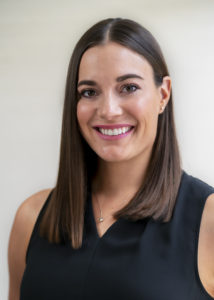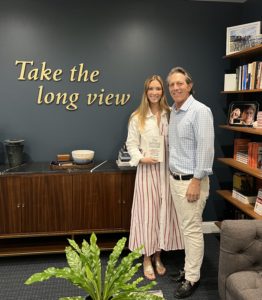Details Are Part of Our Difference
Embracing the Evidence at Anheuser-Busch – Mid 1980s
529 Best Practices
David Booth on How to Choose an Advisor
The One Minute Audio Clip You Need to Hear
Our Newest Team Member: Anna Farrell

Who is that new voice answering the phone at HIG in less than two rings? It’s Anna Farrell, our latest addition to the team. In Anna’s role as Executive Assistant, she is expertly juggling a myriad of tasks, from managing schedules to ordering supplies to welcoming office visitors. Anna allows our team to focus on what they do best: taking care of our clients.
We asked Anna to share a little bit about herself. You’ll understand immediately why we are so excited to have her on the Hill Investment Group team!
FAMILY MATTERS
My husband Graham and I were married in November 2016. We have since added two children to our family, Catherine and Conor. Our dog, Porter, has finally come around to these small humans after learning they always leave behind a trail of food. We live in the Shaw neighborhood in St. Louis where you can find us at one of our favorite neighborhood establishments, walking in Tower Grove Park, or hanging out in our backyard with friends and neighbors.
TRAVEL
Prior to working at HIG, I gained my customer service and hospitality experience working in the Travel Industry. I had the privilege of traveling the world in my twenties when I was a Travel Director at Maritz where I managed onsite logistics for incentive travel programs. My love of travel inspired me to start my own business as a Travel Advisor for Smartflyer where I planned and coordinated the endless details of my clients’ trips. However, two kids and one pandemic later, I am thoroughly enjoying working outside of the travel industry and instead planning my own trips with my husband and kids. The answer to your question is: Japan, France, and Croatia. Those are my top three favorite places I’ve been to.
FRIENDS DESCRIBE ME AS:
Funny, an over-thinker (think Larry David but without the drama), determined, and always equipped with a good story.
IDEAL WEEKEND:
I aspire to be someone who can relax on the weekend, but for now, a good mix of crossing things off of my to-do list and spending time with my family and friends works best for me. We love to frequent the Tower Grove Farmers’ Market, tackle house projects (I’m the visionary, and Graham is the contractor and pro bono laborer), head out for cocktails and a good dinner, or just hang at home and place bets on how many times we will have to put our kids back to bed. As our children mature and work is a little less stressful (thanks to HIG), we hope to start adding family getaways to the docket, but for now, life at home feels really good.
INSPIRED BY:
My parents. My dad was the first person in his family to go to college and then went on to put himself through dental school, working the 5 am shifts cleaning up movie theaters. He has worked tirelessly to create a purposeful and rich life for his family, balancing hard work while simultaneously coaching all of our sports teams, maintaining a perfect lawn, and restoring cars. It does not go unnoticed that he was able to do all of this with the support of my mom, who stayed home with us. She also coached our sports teams, ran the school yearbook, took us on amazing trips, and secretly taught me how to drive a stick-shift. While raising our family, my mom also managed the finances for my dad’s dental practice and, to this day, is one of the techiest people I know. It has been a pure joy to see my parents transition into their new roles as beloved ‘Mimi and Papa’ to our kids.
LIFE AT HIG:
I bring a unique perspective to HIG since I am a lifelong client and friend of the firm. I have first-hand experience being on the receiving end of the high level of customer service and attention to detail that is central to the firm’s core values. As a dedicated Monthly Journal reader, when I saw Katie’s position become available, I knew it would be a good fit since I had known everyone for years and I had a good sense of the team’s comradery and their thoughtful approach to serving their clients. I feel like I have finally found my people – detail-oriented, genuinely nice, family-focused, and just all-around fun.
Meet our Summer Intern

We have a long history of outstanding summer interns and this year’s selection is no exception. Samridhi Sureka joined us in June from Washington Univerisity’s MBA program. What’s Samridhi working on while at HIG? She’s been in a rotational internship program with us where she gets to explore all the elements of the business, from investments and finance to compliance, marketing, and other departments.
Originally from Nagpur, India, where Samridhi spends time helping her family run a sustainable packaging solutions business, she has a talent for supporting large-scale operations and logistics with interest in financial management.
On a personal note, Samridhi loves to cook, and her mission while in St. Louis is to find the best farmers’ market where she can source exceptional ingredients and spices (the hotter, the better) that remind her of home.
We are lucky to have her with us this summer and have enjoyed adding a fresh perspective to HIG.
*Shout out to the great Spencer Burke at Saint Louis Trust and Washington University for connecting us to Samridhi!
The Defining Decade

As HIG’s “client concierge,” I’m often asked about what books I would recommend for younger investors or those new to investing. Two obvious ones have been written about here before: The Psychology of Money by Morgan Housel and Odds On by Matt Hall.
As a concierge, though, after answering the question initially asked, I like to add to an important question that may not have been asked. In this case, “What book would you recommend to my 20-something (child, grandchild, niece, nephew, godchild, etc.) about life and career?” The title that tops my short list is unequivocally, The Defining Decade: Why your twenties matter and how to make the most of them now, by Meg Jay, Ph. D.
While the clear and direct audience is the 20-something, parents, grandparents, and others can also benefit from reading the title. Meg Jay provides an outstanding framework to hold productive conversations with anyone, especially twenty-somethings, based on her years as a clinical psychologist specializing in adult development. Not surprisingly, for our regular readers, Dr. Jay brings plenty of data and evidence along with her anecdotes.
As a parent of three kids in their twenties, I thought it was a great time to revisit this title myself. Fortunately, my wife, Jeana, encouraged our kids to read the book while in high school or college. As all three embark on new careers or career changes, I’m forever grateful to her for discovering this title years ago. Notably, an “updated” 2021 edition provides additional data and evidence since the 2012 original publication.
If you would like to receive a complimentary copy of the book or discuss the topic further, call me at 855-414-5500.

